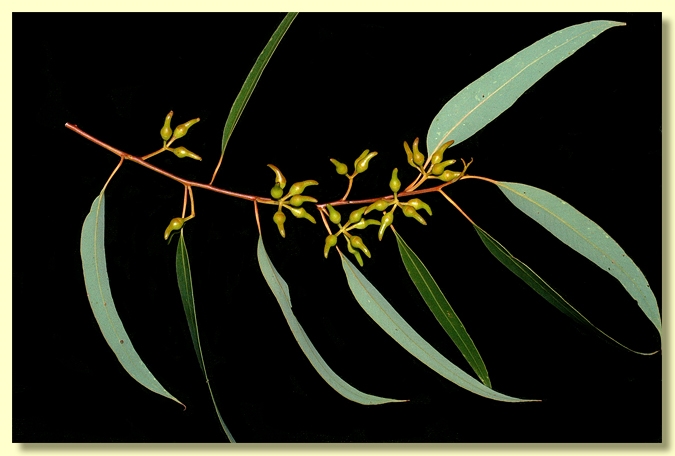Euclid - Online edition
Eucalyptus longirostrata
Eucalyptus | Symphyomyrtus | Latoangulatae | Lepidotae-Fimbriatae
Eucalyptus longirostrata (Blakely) L.A.S.Johnson & K.D.Hill, Fl. Australia 19: 509 (1988).
Eucalyptus punctata var. longirostrata Blakely, Key Eucalypts 101 (1934). T: Benarkin, Qld., June 1917, Forest Inspector Twine; lecto: NSW (fide L.A.S.Johnson & K.D.Hill, Fl. Australia 19: 509 (1988)).
Tree to 30 m tall. Lignotuber absent.
Bark smooth throughout, becoming granular with age and predominantly dull grey to grey-brown, shedding irregularly in strips to expose cream to pale orange to coppery new bark.
Juvenile growth (coppice or field seedlings to 50 cm): stem rounded or square in cross-section; juvenile leaves always petiolate, opposite for 3–5 pairs then alternate, lanceolate, 4–10 cm long, 1.2–2.7 cm wide, base rounded or tapering to petiole, discolorous, green.
Adult leaves alternate, petiole 1–2.5 cm long; blade lanceolate, often slightly falcate, 8–18 cm long, 1.3–3.5 cm wide, base tapering to petiole, sometimes oblique, discolorous, glossy, darker green above and paler on the underside, side-veins greater than 45° to midrib, densely to very densely reticulate, intramarginal vein parallel to and just within margin, oil glands mostly island, occasionally intersectional.
Inflorescence axillary unbranched, peduncles 0.8–1.8 cm long, buds 7 per umbel, pedicellate (pedicels 0.2–0.7 cm long). Mature buds ovoid (0.7–1.5 cm long, 0.4–0.8 cm wide), yellow or creamy, scar present, operculum relatively long and distinctly beaked, stamens inflexed, anthers oblong, versatile, dorsifixed, dehiscing by longitudinal slits (non-confluent), style long, stigma tapered, locules 3 or 4, the placentae usually with 4 vertical ovule rows. Flowers white.
Fruit pedicellate (pedicels 0.2–0.6(0.9) cm long), hemispherical to cupular, 0.3–0.8 cm long, 0.6–1 cm wide, disc slightly raised, level or slightly descending, valves 3 or 4, exserted.
Seeds black, 1–2 mm long, cuboid or obliquely pyramidal, dorsal surface pitted, margins distinctly toothed, hilum terminal or obliquely positioned.
Cultivated seedlings (measured at ca node 10): cotyledons bilobed to oblong; stems square in cross-section; leaves always petiolate, opposite for 4–5 nodes then alternate, lanceolate, 6–11 cm long, 1.4–3 cm wide, base rounded to tapering, discolorous, darker green above, paler beneath.
Flowering has been recorded in February and March.
A medium-sized to tall tree endemic to south-east Queensland from the Expedition Range – Blackdown Tableland area, south through the Carnarvon Range, Cracow, Taroom area and further east into the Monto, Mundubbera region and then south through the Kilkivan, Nanango, Kingaroy, Yarraman region as far south as Clifton near Toowoomba and west to Barakula State Forest. Characterised by its smooth, dull, grey gum bark, which matures to a granular texture and sheds in irregular patches to leave bright orange to coppery new bark, the discolorous adult leaves that are paler on the underside, and the relatively long beaked operculum.
Eucalyptus longirostrata belongs in Eucalyptus subgenus Symphyomyrtus section Latoangulatae because cotyledons are bilobed, leaves are discolorous and have side-veins at a wide angle to the midrib, buds have two opercula and fruit have exserted valves. Within this section, it is one of six species forming series Lepidotae-Fimbriatae (the Grey gums) with ovules in 4(6) rows and the bark smooth throughout becoming granular with age. The series Lepidotae-Fimbriatae can be informally divided further into two groups based on seed colour and the presence or absence of small teeth on the seed edge. E. punctata, E. canaliculata, E. longirostrata and E. grisea all have black seed that are prominently toothed along the edges. E. propinqua and E. major have brown to light brown seed that have a much smoother surface texture than the other group, lacking the prominent teeth on the seed edge. Also the bark of E. propinqua and E. major tends to shed in strips rather than patches like the other grey gums.
Eucalyptus longirostrata can be easily separated from all the other grey-gums by its long, distinctly beaked operculum.
Eucalyptus longirostrata: Latin longus, long and -rostratus, beaked or curved, referring to the long, beaked operculum.













